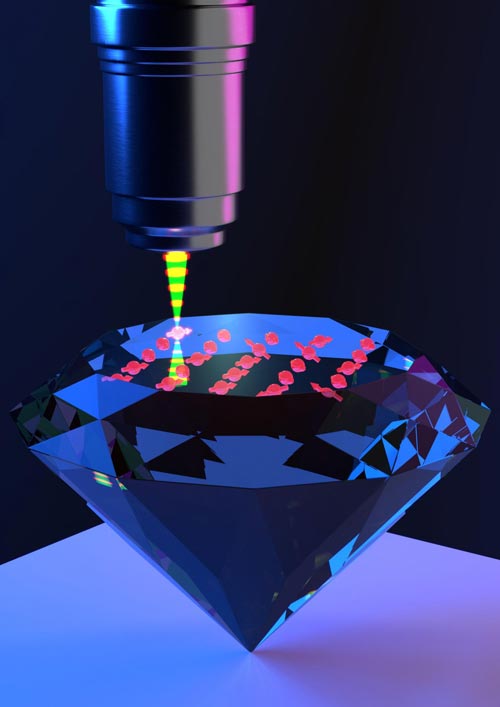Accelerating quantum technologies with materials processing at the atomic scale

Laser writing of individual nitrogen-vacancy defects in diamond with near-unity yield. Credit: Oxford University
However a major challenge in developing these technologies is that the quantum phenomena are very fragile, and only a handful of physical systems have been identified in which they survive long enough and are sufficiently controllable to be useful.
Atomic defects in materials such as diamond are one such system, but a lack of techniques for fabricating and engineering crystal defects at the atomic scale has limited progress to date.
A team of scientists demonstrate, in a paper published in Optica, the success of the new method to create particular defects in diamonds known as nitrogen-vacancy (NV) colour centres. These comprise a nitrogen impurity in the diamond (carbon) lattice located adjacent to an empty lattice site or vacancy.
The NV centres are created by focusing a sequence of ultrafast laser pulses into the diamond, the first of which has an energy high enough to generate vacancies at the centre of the laser focus, with subsequent pulses at a lower energy to mobilise the vacancies until one of them binds to a nitrogen impurity and forms the required complex.
The new research was carried out by a team led by Prof Jason Smith in the Department of Materials, University of Oxford, and Dr Patrick Salter and Prof Martin Booth in the Dept of Engineering Science, University of Oxford, in collaboration with colleagues at the University of Warwick.
It took place within the research programme of NQIT, the Quantum Computing Technology Hub of the UK Quantum Technologies Programme, with support from DeBeers UK who supplied the diamond sample.
The scientists' new method involves a sensitive fluorescence monitor being employed to detect light emitted from the focal region, so that the process can be actively controlled in response to the observed signal.
By combining local control and feedback, the new method facilitates the production of arrays of single NV centres with exactly one colour centre at each site – a key capability in building scalable technologies. It also allows precise positioning of the defects, important for the engineering of integrated devices. The rapid single-step process is easily automated with each NV centre taking only seconds to create.
Prof Martin Booth says: 'Colour centres in diamond offer a very exciting platform for developing compact and robust quantum technologies, and this new process is a potential game-changer in the engineering of the required materials. There is still more work to do in optimising the process, but hopefully this step will help to accelerate delivery of these technologies.'
The scientists believe that this method might ultimately be used to fabricate centimetre-sized diamond chips containing 100,000 or more NV centres as a route towards the 'holy grail' of quantum technologies, a universal fault-tolerant quantum computer.
Prof Jason Smith says: 'The first quantum computers are now starting to emerge but these machines, impressive as they are, only scratch the surface of what might be achieved and the platforms being used may not be sufficiently scalable to realise the full power that quantum computing has to offer.
Diamond colour centres may provide a solution to this problem by packing high densities of qubits onto a solid state chip, which could be entangled with each other using optical methods to form the heart of a quantum computer. The ability to write NV centres into diamond with a high degree of control is an essential first step towards these and other devices.'
###
For more information or to request images, please contact the University of Oxford press office at ruth.abrahams@admin.ox.ac.uk / 01865 280730.
The paper is available here: https:/
Notes to editors
About the University of Oxford
Oxford University has been placed number 1 in the Times Higher Education World University Rankings for the third year running, and at the heart of this success is our ground-breaking research and innovation. Oxford is world-famous for research excellence and home to some of the most talented people from across the globe. Our work helps the lives of millions, solving real-world problems through a huge network of partnerships and collaborations. The breadth and interdisciplinary nature of our research sparks imaginative and inventive insights and solutions. Through its research commercialisation arm, Oxford University Innovation, Oxford is the highest university patent filer in the UK and is ranked first in the UK for university spinouts, having created more than 170 new companies since 1988. Over a third of these companies have been created in the past three years.
NQIT
NQIT, the UK quantum computing technology hub, is the largest of the four Hubs in the UK National Quantum Technologies Programme. NQIT is a consortium of nine universities and organisations, led by University of Oxford, working towards building a quantum computer demonstrator and creating a quantum computing sector in the UK.
Media Contact
More Information:
http://dx.doi.org/10.1364/OPTICA.6.000662All latest news from the category: Information Technology
Here you can find a summary of innovations in the fields of information and data processing and up-to-date developments on IT equipment and hardware.
This area covers topics such as IT services, IT architectures, IT management and telecommunications.
Newest articles

Innovative vortex beam technology
…unleashes ultra-secure, high-capacity data transmission. Scientists have developed a breakthrough optical technology that could dramatically enhance the capacity and security of data transmission (Fig. 1). By utilizing a new type…

Tiny dancers: Scientists synchronise bacterial motion
Researchers at TU Delft have discovered that E. coli bacteria can synchronise their movements, creating order in seemingly random biological systems. By trapping individual bacteria in micro-engineered circular cavities and…

Primary investigation on ram-rotor detonation engine
Detonation is a supersonic combustion wave, characterized by a shock wave driven by the energy release from closely coupled chemical reactions. It is a typical form of pressure gain combustion,…



